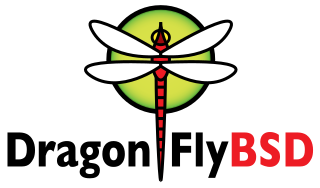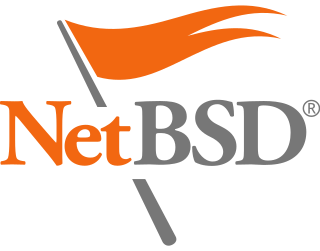Related Research Articles
The Open Sound System (OSS) is an interface for making and capturing sound in Unix and Unix-like operating systems. It is based on standard Unix devices system calls. The term also sometimes refers to the software in a Unix kernel that provides the OSS interface; it can be thought of as a device driver for sound controller hardware. The goal of OSS is to allow the writing of sound-based applications that are agnostic of the underlying sound hardware.

DragonFly BSD is a free and open-source Unix-like operating system forked from FreeBSD 4.8. Matthew Dillon, an Amiga developer in the late 1980s and early 1990s and FreeBSD developer between 1994 and 2003, began working on DragonFly BSD in June 2003 and announced it on the FreeBSD mailing lists on 16 July 2003.

Matthew Dillon is an American software engineer known for Amiga software, contributions to FreeBSD and for starting and leading the DragonFly BSD project since 2003.
Hardware abstractions are sets of routines in software that provide programs with access to hardware resources through programming interfaces. The programming interface allows all devices in a particular class C of hardware devices to be accessed through identical interfaces even though C may contain different subclasses of devices that each provide a different hardware interface.

XNU is the computer operating system (OS) kernel developed at Apple Inc. since December 1996 for use in the Mac OS X operating system and released as free and open-source software as part of the Darwin OS, which is the basis for the Apple TV Software, iOS, iPadOS, watchOS, and tvOS OSes. XNU is an abbreviation of X is Not Unix.

The Linux kernel provides several interfaces to user-space applications that are used for different purposes and that have different properties by design. There are two types of application programming interface (API) in the Linux kernel that are not to be confused: the "kernel–user space" API and the "kernel internal" API.
"Zero-copy" describes computer operations in which the CPU does not perform the task of copying data from one memory area to another or in which unnecessary data copies are avoided. This is frequently used to save CPU cycles and memory bandwidth in many time consuming tasks, such as when transmitting a file at high speed over a network, etc., thus improving performances of programs (processes) executed by a computer.

In a computer, the Advanced Configuration and Power Interface (ACPI) provides an open standard that operating systems can use to discover and configure computer hardware components, to perform power management e.g. putting unused hardware components to sleep, to perform auto configuration e.g. Plug and Play and hot swapping, and to perform status monitoring. First released in December 1996, ACPI aims to replace Advanced Power Management (APM), the MultiProcessor Specification, and the Plug and Play BIOS (PnP) Specification. ACPI brings power management under the control of the operating system, as opposed to the previous BIOS-centric system that relied on platform-specific firmware to determine power management and configuration policies. The specification is central to the Operating System-directed configuration and Power Management (OSPM) system. ACPI defines hardware abstraction interfaces between the devices firmware, the computer hardware components, and the operating systems.

NDISwrapper is a free software driver wrapper that enables the use of Windows XP network device drivers on Linux operating systems. NDISwrapper works by implementing the Windows kernel and NDIS APIs and dynamically linking Windows network drivers to this implementation. As a result, it only works on systems based on the instruction set architectures supported by Windows, namely IA-32 and x86-64.
In computing, ioctl is a system call for device-specific input/output operations and other operations which cannot be expressed by regular system calls. It takes a parameter specifying a request code; the effect of a call depends completely on the request code. Request codes are often device-specific. For instance, a CD-ROM device driver which can instruct a physical device to eject a disc would provide an ioctl request code to do so. Device-independent request codes are sometimes used to give userspace access to kernel functions which are only used by core system software or still under development.
There are a number of Unix-like operating systems based on or descended from the Berkeley Software Distribution (BSD) series of Unix variant options. The three most notable descendants in current use are FreeBSD, OpenBSD, and NetBSD, which are all derived from 386BSD and 4.4BSD-Lite, by various routes. Both NetBSD and FreeBSD started life in 1993, initially derived from 386BSD, but in 1994 migrating to a 4.4BSD-Lite code base. OpenBSD was forked from NetBSD in 1995. Other notable derivatives include DragonFly BSD, which was forked from FreeBSD 4.8, and Apple Inc.'s iOS and macOS, with its Darwin base including a large amount of code derived from FreeBSD.

Wireless network cards for computers require control software to make them function. This is a list of the status of some open-source drivers for 802.11 wireless network cards.
These tables compare free software / open-source operating systems. Where not all of the versions support a feature, the first version which supports it is listed.
A proprietary device driver is a closed-source device driver published only in binary code. In the context of free (libre) and open-source software, a proprietary device driver is referred to as a blob or binary blob. The term usually refers to a proprietary kernel module loaded into the kernel of an open-source operating system, although blobs can be included as hexadecimal arrays in source code, as some are in the Linux kernel, and is sometimes also applied to code running outside the kernel, such as system firmware images, microcode updates, or userland programs. The term blob was first used in database management systems to describe a collection of binary data stored as a single entity.
Vinum is a logical volume manager, also called software RAID, allowing implementations of the RAID-0, RAID-1 and RAID-5 models, both individually and in combination. The original Vinum was part of the base distribution of the FreeBSD operating system since 3.0, and also NetBSD between 2003-10-10 and 2006-02-25, as well as descendants of FreeBSD, including DragonFly BSD; in more recent versions of FreeBSD, it has been replaced with gvinum, which was first introduced around FreeBSD 6. Vinum source code is maintained in the FreeBSD and DragonFly source trees. Vinum supports RAID levels 0, 1, 5, and JBOD. Vinum was inspired by Veritas Volume Manager.
A Bluetooth stack is software that is an implementation of the Bluetooth protocol stack.

Kernel-based Virtual Machine (KVM) is a virtualization module in the Linux kernel that allows the kernel to function as a hypervisor. It was merged into the mainline Linux kernel in version 2.6.20, which was released on February 5, 2007. KVM requires a processor with hardware virtualization extensions, such as Intel VT or AMD-V. KVM has also been ported to other operating systems such as FreeBSD and illumos in the form of loadable kernel modules.
Kqueue is a scalable event notification interface introduced in FreeBSD 4.1 on July 2000, also supported in NetBSD, OpenBSD, DragonFly BSD, and macOS. Kqueue was originally authored in 2000 by Jonathan Lemon, then involved with the FreeBSD Core Team. Kqueue makes it possible for software like nginx to solve the c10k problem.

NetBSD is a free and open-source Unix-like operating system based on the Berkeley Software Distribution (BSD). It was the first open-source BSD descendant officially released after 386BSD was forked. It continues to be actively developed and is available for many platforms, including servers, desktops, handheld devices, and embedded systems.
NVM Express (NVMe) or Non-Volatile Memory Host Controller Interface Specification (NVMHCIS) is an open, logical-device interface specification for accessing a computer's non-volatile storage media usually attached via PCI Express (PCIe) bus. The acronym NVM stands for non-volatile memory, which is often NAND flash memory that comes in several physical form factors, including solid-state drives (SSDs), PCI Express (PCIe) add-in cards, and M.2 cards, the successor to mSATA cards. NVM Express, as a logical-device interface, has been designed to capitalize on the low latency and internal parallelism of solid-state storage devices.
References
- 1 2 3 4 5 Jason R Thorpe; NASA Ames Research Center (1998). A Machine-Independent DMA Framework for NetBSD (PDF). Proceedings of the FREENIX Track: 1998 USENIX Annual Technical Conference. USENIX.
- 1 2 David Chisnall (2006-10-06). "NetBSD: Not Just for Toasters". InformIT . Prentice Hall Professional . Retrieved 2019-07-25.
- ↑ Jason R Thorpe; NASA Ames Research Center (1997). "bus_dma, … — Bus and Machine Independent DMA Mapping Interface". BSD Cross Reference. NetBSD, FreeBSD, OpenBSD, DragonFly BSD.
- "BUS_DMA(9)". FreeBSD Manual Pages.
- "BUS_DMAMAP_CREATE(9)". OpenBSD manual page server.
- "BUS_DMA(9)". DragonFly On-Line Manual Pages.
- ↑ Christopher G. Demetriou (1997). "bus_space, … — bus space manipulation functions". BSD Cross Reference. NetBSD, FreeBSD, OpenBSD, DragonFly BSD.
- "BUS_SPACE(9)". FreeBSD Manual Pages.
- "BUS_SPACE(9)". OpenBSD manual page server.
- "BUS_SPACE(9)". DragonFly On-Line Manual Pages.